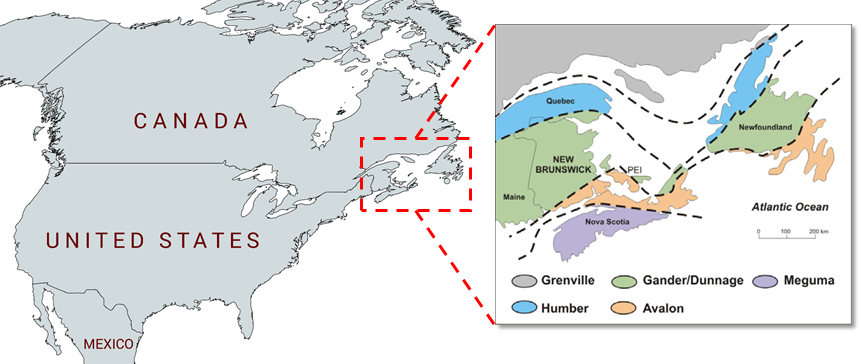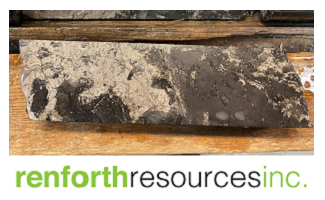At the Prospectors & Developers Association of Canada (PDAC) convention this year, there is a technical session titled the “Gold mineralization in Newfoundland” on Wednesday, June 15 in Room 713.
Currently there is a “gold rush” occurring on the island of Newfoundland with more than 50 companies exploring for gold.
In 2021, exploration expenditures in the province nearly doubled to over $127 million.
In 2022, the Valentine Gold Project was approved to proceed and this project will be the largest gold mine in Atlantic Canada when completed.
Speakers at the session will include representatives from companies including Matador Mining (ASX:MZZ) and New Found Gold (TSXV:NFG).
- Matador Mining is a gold exploration company engaged in mining and mineral exploration activities. The company holds a 100% interest in the Cape Ray gold project located in south-west Newfoundland, Canada, which hosts a JORC resource of 0.837 million gold ounces (12.9 million tonnes at 2.02 g/t gold). The company is based in West Perth, Australia.
- New Found Gold is a mineral exploration company engaged in the identification, acquisition, and exploration of gold properties in the provinces of Newfoundland and Labrador and Ontario, Canada. The company holds an interest in the Queensway project comprising an area of 151,030 hectares of land located near Gander, Newfoundland.
Recently, eResearch published a 42-page report on the Atlantic Gold Belt, highlighting various companies, including over 20 companies active in the province of Newfoundland and Labrador.
Here is an expert from the report:
Geology and Mineralization of the Island of Newfoundland
The island of Newfoundland forms the eastern part of the Appalachian Gold Belt in North America.
The island consists of four main tectonic zones (see Figure 1):
- Avalon zone,
- Gander and Dunnage zones,
- Humber zone.
The main types of gold mineralization found in Newfoundland are epithermal, orogenic (mesothermal), and VMS.
VMS deposits are primarily found in the Dunnage zone, epithermal-type deposits are found in the Avalon and Gander zones, and orogenic-type deposits are mostly found in the Dunnage and Gander zones.
The Avalon zone, which extends from South Carolina to southeastern Newfoundland, was the location of the first major gold producer in the province, Hope Brook Gold Mine that produced 752,000 ounces of gold from 1986 through 1997.
History of Mining in Newfoundland and Labrador
Although mining in Newfoundland and Labrador predates European settlement in the area, including Vikings mining for bog iron near their settlement in L’Anse aux Meadows, commercial mining was not attempted until the 1850s.
One of the first successful commercial operations was the Tilt Cove copper mine in north-central Newfoundland within the Baie Verte mining district. The mine opened in 1864 and operated until 1920 before a resurgence of activity from 1957-1967, and some stockpile processing in 2011. Currently, Anaconda Mining Inc. (TSX:ANX) [now Signal Gold Inc. (TSX:SGNL)] owns the project and is actively exploring the area.
Commercial gold mining first appeared in Newfoundland in the early 1900s. The Goldenville Mine, located near Ming’s Bight, was the first gold mine with construction beginning in 1903. The Browning gold mine near Sops Arm produced 149 ounces of gold in 1903 but both mines were short-lived.
Gold exploration in the province restarted in the 1970s with the Cape Ray discovery in western Newfoundland and the Hope Brook gold deposit that was mined from 1986 until 1997.
Signal Gold currently operates the Point Rousse Project and both Marathon Gold (TSX:MOZ) and Maritime Resources (TSXV:MAE) have late-stage projects that are aiming for gold production in the 2022-2023 time frame. Recently there has been renewed interest in the region with high-grade drill results from New Found Gold.
FIGURE 1: Tectonic Zones of the Northeastern Appalachian Mountain Belt

About the PDAC 2022 Convention
The PDAC Convention provides a global platform that allows mineral exploration and mining companies from across the world to network, collaborate, learn, and do business together.
The PDAC 2022 Convention will take place in person at the Metro Toronto Convention Centre in Toronto, Canada from June 13-15 and online from June 28-29.
For more information about the PDAC convention, please visit http://www.pdac.ca/convention/
To learn more about the technical session titled the “Gold mineralization in Newfoundland” on Wednesday, June 15 in Room 713, from 2:30pm-4:00pm, click here.
The PDAC Convention hosts the Investor Exchange that is hub for mining companies of all sizes to connect in person (and online) with investors. To see a directory of exhibitors, please visit the PDAC 2022 Exhibitor Directory.
Notes: All numbers in CAD unless otherwise stated. The author of this report, and employees, consultants, and family of eResearch may own stock positions in companies mentioned in this article and may have been paid by a company mentioned in the article or research report. eResearch offers no representations or warranties that any of the information contained in this article is accurate or complete. Articles on eresearch.com are provided for general informational purposes only and do not constitute financial, investment, tax, legal, or accounting advice nor does it constitute an offer or solicitation to buy or sell any securities referred to. Individual circumstances and current events are critical to sound investment planning; anyone wishing to act on this information should consult with a financial advisor. The article may contain “forward-looking statements” within the meaning of applicable securities legislation. Forward-looking statements are based on the opinions and assumptions of the Company’s management as of the date made. They are inherently susceptible to uncertainty and other factors that could cause actual events/results to differ materially from these forward-looking statements. Additional risks and uncertainties, including those that the Company does not know about now or that it currently deems immaterial, may also adversely affect the Company’s business or any investment therein. Any projections given are principally intended for use as objectives and are not intended, and should not be taken, as assurances that the projected results will be obtained by the Company. The assumptions used may not prove to be accurate and a potential decline in the Company’s financial condition or results of operations may negatively impact the value of its securities. Please read eResearch’s full disclaimer.




In 2022, the Valentine Gold Project was approved to proceed and this project will be the largest gold mine in Atlantic Canada when completed.